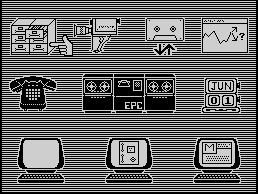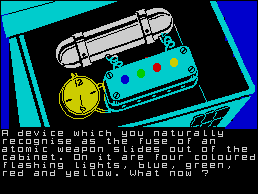EXCLUSIVE
WARNING - possible breach of the Fourth Protocol ...
As John Preston, and newly appointed head of C1(A) it is your job to look after military security and, ultimately, uncover a British traitor and a plan to destabilise a nation of the Western Alliance.
The game comprises three sections, called The NATO Documents, The Bomb and The SAS Assault. In order to get into the last two you must use a code which is given to you in the previous section.
You begin in your office, reading memos sent by your superiors, using the phone, despatching watchers to tail suspects and receiving reports on the movements of potential traitors.
The game is controlled using a series of innovative and visually attractive icon screens. All input is made by moving a pointing finger to one of the icons and pressing ENTER.

Three terminals at the bottom of the screen provide contact with the outside world. The one on the left is used to read reports from watchers, the middle one gives you access to your reports and the one on the right allows you to read your memos.
File access is gained through the CenCom computer located in the basement of your office building. You can put your own files on the system or run checks and voiceprints on characters.
Files not held on CenCom can be accessed by ringing Blenheim and entering the correct code.
Once you have the file code the second section of the game can be loaded. The Bomb covers a trip around the building picking up useful objects for your search across Britain to find the nuclear device.
The building has four floors, connected by lifts. Although icon-driven, the options are flexible enough to allow characters to talk to you and for you to move easily and quickly.

Once you have located the bomb you can access the third and undoubtedly the weakest part of the game, The SAS Assault. You must arm your squad and place them around the building using a schematic plan. In this sequence you use simple verb/noun sentences with a list of words available on request.
Having blasted your way to the room containing the bomb, you have only seconds in which to defuse it, all the while fighting off KGB guards.
Two seemingly irrelevant bits of information, chanced upon earlier in the game, are necessary to successfully render the device harmless.
The Fourth Protocol is the work of the Electric Pencil team and that is shown in the professional polish of the game. The icon graphics are excellent and the speed is incredible.
Although some icon actions, such as those used for movement, can take longer than traditional adventure text input, their use generates a high tech atmosphere in keeping with the game.
It is one of the most enjoyable, complex but easy to operate games which I have played in a long time. Even if you do not like the Frederick Forsyth book you will, nevertheless, like the software.
Publisher Century/Hutchinson
Price £12.95 Memory 48K
***** |
|
| John Gilbert |
| 